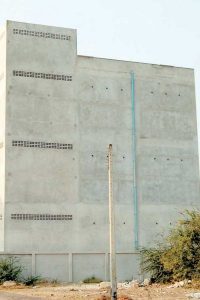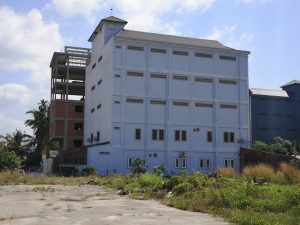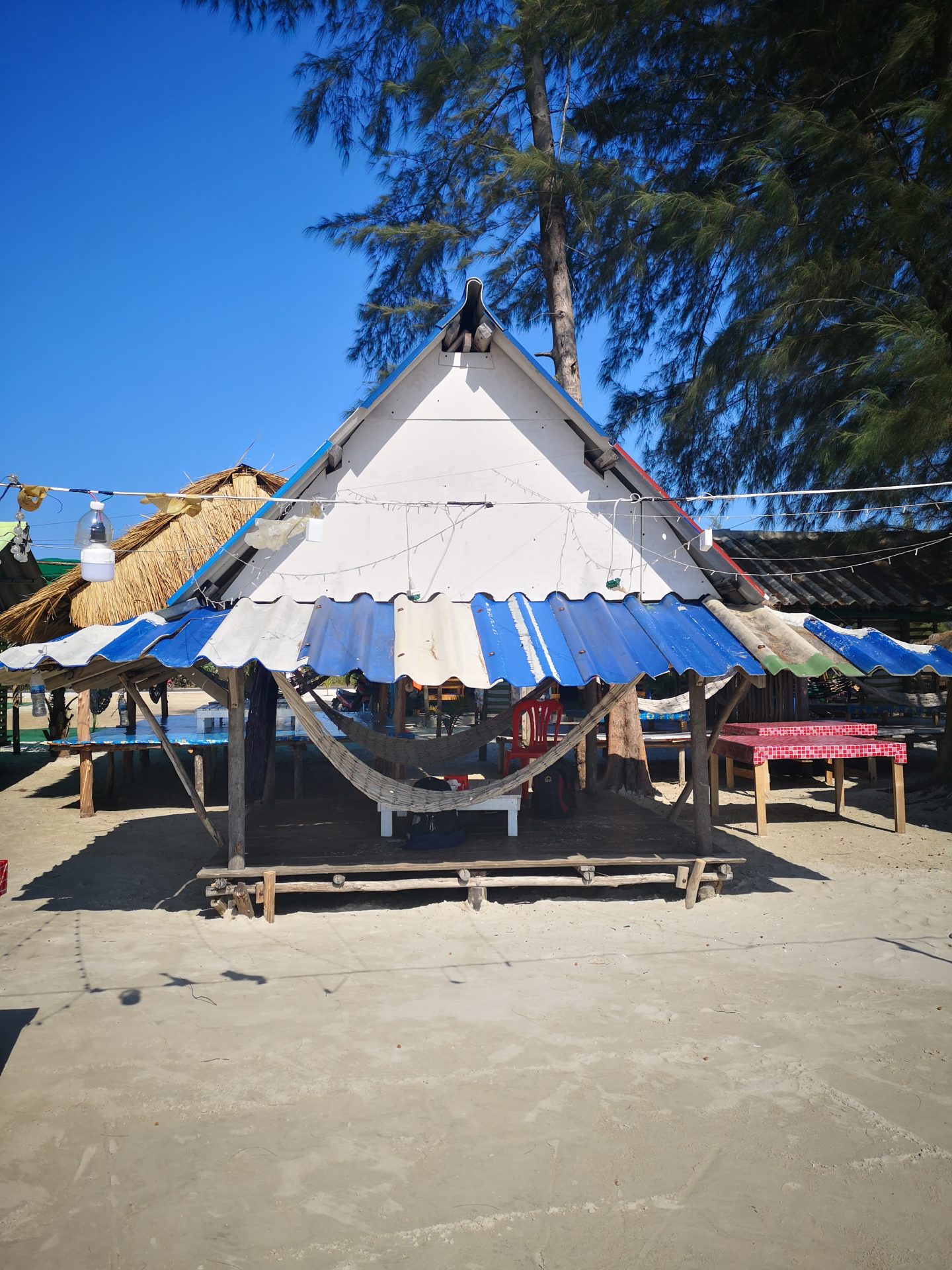$1000 a kilo! My jaw drops in disbelief……….
By the seat of our pants, we are heading to Koh Kong, a small town near the border with Thailand, from Cambodia’s capital, Phnom Penh. Our minibus, the Vibol Express is the fastest vehicle on the road. We are never overtaken. I survive the journey by having faith in the seatbelt (with which this minibus is unusually fitted) and by keeping my head in a book (by avoiding the horror of the road ahead, I can delude myself that the situation is fine). The trip is uninspiring. The outskirts of Phnom Penh are a building site, the suburbs an ugly strip of clothing factories and the road verges awash with rubbish.
 Occasionally, I glance out the window, careful to avoid the road ahead. We are travelling through small patches of forest, cleared and scorched at the roadside, and through farmland. As we approach Koh Kong, I notice huge and unusual buildings. Some, the size and shape of Greek orthodox monasteries, but as solid, grey and concrete as a factory painted by Lowry. These are not the simple, stilted timber structures we are used to seeing in the Cambodian countryside. These are formidable buildings with large air bricks as windows and open turret roofs. They must cost a small fortune to construct. They are not dwellings or hotels. We conclude that they must be a specialist silo of some nature, but they seem too elaborate for storing rice and there are surely too many of the buildings for the amount of rice fields that we see. There are huge speakers attached to the buildings piping out bird noises, perhaps that of a bird of prey to keep small birds away from grains. (It will take me 24 hours of investigation to find the true use for these buildings and it is quite a surprise).
Occasionally, I glance out the window, careful to avoid the road ahead. We are travelling through small patches of forest, cleared and scorched at the roadside, and through farmland. As we approach Koh Kong, I notice huge and unusual buildings. Some, the size and shape of Greek orthodox monasteries, but as solid, grey and concrete as a factory painted by Lowry. These are not the simple, stilted timber structures we are used to seeing in the Cambodian countryside. These are formidable buildings with large air bricks as windows and open turret roofs. They must cost a small fortune to construct. They are not dwellings or hotels. We conclude that they must be a specialist silo of some nature, but they seem too elaborate for storing rice and there are surely too many of the buildings for the amount of rice fields that we see. There are huge speakers attached to the buildings piping out bird noises, perhaps that of a bird of prey to keep small birds away from grains. (It will take me 24 hours of investigation to find the true use for these buildings and it is quite a surprise).
 We arrive in Koh Kong in one piece. It’s a scruffy little town with cheap accommodation. Nothing really happens here, it’s just a place to springboard to Thailand or into the Cardamom mountains, (which is our destination), but as we’re here, we explore. We hire bikes and cycle to Koh Lor beach. En route we spot a bird of prey and a kingfisher and notice that the crab shack restaurant, Thmorda’s, is unfortunately morphing into a dinosaur theme park.
We arrive in Koh Kong in one piece. It’s a scruffy little town with cheap accommodation. Nothing really happens here, it’s just a place to springboard to Thailand or into the Cardamom mountains, (which is our destination), but as we’re here, we explore. We hire bikes and cycle to Koh Lor beach. En route we spot a bird of prey and a kingfisher and notice that the crab shack restaurant, Thmorda’s, is unfortunately morphing into a dinosaur theme park.
Along the beach, rough shelters give respite from the heat of the sun and the hot sand. The shelters are built cheek by jowl up to the wash, so there’s little sand to walk on. What there is is home to sand flies, so we spray on the repellant. Plastic litters the beach, not in shocking amounts, but it’s enough to put me off swimming. There’s only a handful of people here. It’s quiet and relaxing listening to the sound of the sea and we spend the day in a hammock beneath a shelter, drinking iced coffee and reading.
 There’s a small campsite called Hula Hula at the end of the beach where you can sleep under a mosquito net directly facing the sea. Quite pleasant I should think as long as a karaoke bar doesn’t crank up of an evening.
There’s a small campsite called Hula Hula at the end of the beach where you can sleep under a mosquito net directly facing the sea. Quite pleasant I should think as long as a karaoke bar doesn’t crank up of an evening.
Compared to the budget hotels in town, the camp isn’t cheap. $10 a night for shared facilities, where a hotel is only $12, but it’s clearly the place to come for the experience of sleeping on the beach and the camp seems to draw young backpackers and retired older men.
Koh Kong is off the banana pancake trail, it’s not a cool and happening place. Generally the youth appear to prefer to visit the trendy islands further south from Sihanoukville. There’s a limited choice of restaurants, no yoga, vegan cafes or patisseries here, so it’s definitely not classy enough and therefore avoided by trendy travellers and the crowd of mature middle class single female travellers that we encountered in Southern Laos. However, there is an abundance of mature, tattooed and retired men. It’s cheap to live here and the pension goes far. Once renowned for prostitution and gambling, the town has done much to clean up its act and reputation, but its still easy to find ‘love’, a full English breakfast and there’s abundant WiFi and satellite TV.
For young women in Myanmar, taking monastic orders is a way out of poverty and abuse. In Cambodia, paedophilia is slowly being combated and the problem taken seriously by the authorities, but there seems a reluctance to acknowledge and combat the ugly and significant industry of virgin buying. Approximately 10% of the population in Cambodia, those living mainly in the countryside, live in extreme poverty and as a result, a daughter’s virginity is often considered a commodity. This is not paedophilia. The rich and powerful men who make the purchases will often sponsor a pretty young girl and support the family until the girl reaches puberty and is then taken to be used. In Cambodia there is a code of duty and obedience known as chbab srey, or ‘law for women’. It dictates that women must obey and help their parents, a rule that is almost always followed. Arrangements are commonly brokered by a girl’s mother or aunt. Women who themselves have often been abused and may have had to prostitute themselves to survive and feed their families.
With such great hardship, it’s not a surprise that some Cambodian young women choose to be the girlfriend or to marry a western or more recently, a better financial bet, a Chinese man, to assist and to care for them. We all desire care and care can take many forms.
Lovely Alistair from Aberdeen, ex pat of 15 years, told me that he travelled freely for many years but, ultimately ‘just wanted to settle down’. He now lives happily with his Cambodian wife and they run a restaurant together. There are mutually beneficial arrangements in all relationships.
 Alistair laughs as I ask him about the strange buildings with piped bird calls that are so common in Koh Kong. I discover that they are not for storage, they are for collection. The buildings are roosts. The speakers transmit Swallow bird calls to encourage the little birds into the buildings and to nest. After the eggs hatch and the birds fly, the nests are collected and exported to China to be used to make bird’s nest soup or for use in skincare, anti-cancer regiments and as a treatment for impotence. It’s a lucrative business, $1000 for a kilo for unclean ‘nuggets’ and cleaned bird’s nests, can be sold for up to $3,000 a kilo. Koh Kong’s nests are considered the best. The business is worth the investment and smallholders have recently built over 1000 four or five storey concrete swallow houses across the province. Many homes in town also include a few extra stories on top as a bird box!
Alistair laughs as I ask him about the strange buildings with piped bird calls that are so common in Koh Kong. I discover that they are not for storage, they are for collection. The buildings are roosts. The speakers transmit Swallow bird calls to encourage the little birds into the buildings and to nest. After the eggs hatch and the birds fly, the nests are collected and exported to China to be used to make bird’s nest soup or for use in skincare, anti-cancer regiments and as a treatment for impotence. It’s a lucrative business, $1000 for a kilo for unclean ‘nuggets’ and cleaned bird’s nests, can be sold for up to $3,000 a kilo. Koh Kong’s nests are considered the best. The business is worth the investment and smallholders have recently built over 1000 four or five storey concrete swallow houses across the province. Many homes in town also include a few extra stories on top as a bird box!
Cambodia continues to surprise me.
